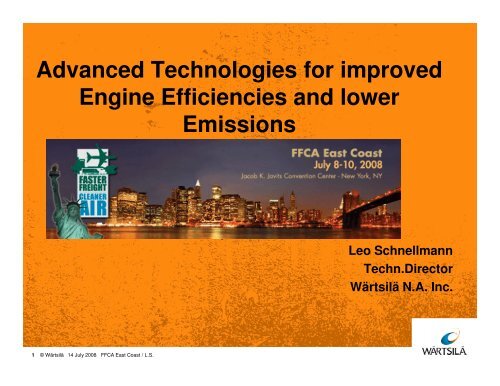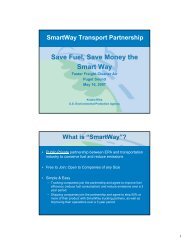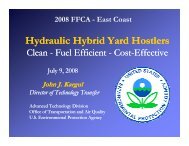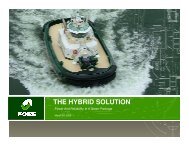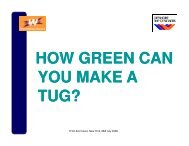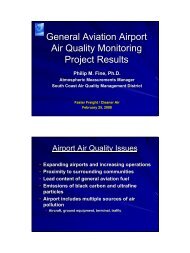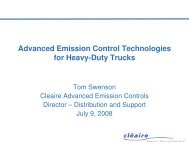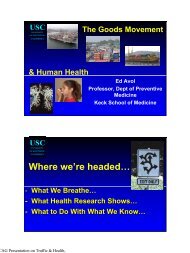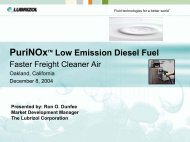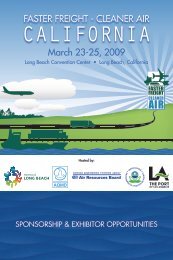Technologies - Faster Freight - Cleaner Air
Technologies - Faster Freight - Cleaner Air
Technologies - Faster Freight - Cleaner Air
- No tags were found...
Create successful ePaper yourself
Turn your PDF publications into a flip-book with our unique Google optimized e-Paper software.
Advanced <strong>Technologies</strong> for improvedEngine Efficiencies and lowerEmissions<strong>Faster</strong> <strong>Freight</strong> – <strong>Cleaner</strong> <strong>Air</strong> East CoastJacob K. Javits Convention CenterJuly 8-10, 2008Leo SchnellmannTechn.DirectorWärtsilä N.A. Inc.1 © Wärtsilä 14 July 2008 FFCA East Coast / L.S.
AgendaEmission control technologiesAlternative solutions in sensitive areasAlternatives to fossil fuelSummary2 © Wärtsilä 14 July 2008 FFCA East Coast / L.S.
Development on Emission regulation3 © Wärtsilä 14 July 2008 FFCA East Coast / L.S.
<strong>Technologies</strong>Technology categorisationEngine-internal measures without using additional agents:Low-NOx tuningLow-NOx injectionEngine-internal measures employing additional agents- “wet technologies”:EmulsionsDirect water injection (DWI)WaCoReGExhaust after treatment measuresSelective catalytic reduction (SCR4 © Wärtsilä 14 July 2008 FFCA East Coast / L.S.
Engine Technology RT-flex conceptThe fully electronically controlled common rail system has greatemission influencing capabilities5 © Wärtsilä 14 July 2008 FFCA East Coast / L.S.
Engine Technology RT-flex conceptWärtsilä RT-flex common rail technologyFree selection of various injection patternsPre-injection Triple injection Sequential injectionNeedle liftInjection pressureCylinder pressureFuel pressure rail6 © Wärtsilä 14 July 2008 FFCA East Coast / L.S.
Engine Technology RT-flex conceptWärtsilä RT-flex common rail technologySequential operation of single injection nozzles1-nozzle operation for super-dead-slow operationsmokeless down to 10 to 12% rpm R1(12rpm for 6RT-flex58T-B)7 © Wärtsilä 14 July 2008 FFCA East Coast / L.S.
Engine TechnologyLow-NOx tuningStandard for all RTA and RT-flex engines.All Wärtsilä RTA and RT-flex engines installed on ships with keel-laying on or afterJanuary 1st, 2000 comply with Regulation 13 of Annex VI to MARPOL 73/78.This has been achieved by means of:Increased compression ratioInjection delayModified exhaust valve timingNOx [g/kW h]23222120191817161514131211100 50 100 150 200Rated Engine Speed [rpm]IMO NOx limitRTA96CRTA84CRTA84T-BRTA72U-BRTA62U-BRTA58T-BRTA52U-BRTA48T-BRTA96CRTA84CRTA84T-BRTA72U-BRTA68T-BRTA62U-BRTA58T-BRTA52U-BRTA48T-BThe penalty of low NOx tuning is 2 - 3 g/kWh higher fuel consumption8 © Wärtsilä 14 July 2008 FFCA East Coast / L.S.
„ Wet <strong>Technologies</strong>“Water-fuel emulsion– Limitations due to requirements for heating of the fuel system(viscosity of the emulsion)– Limitations due to the capacity of the fuel pumps– Load-dependent mixing of fuel and water in the emulsifierAbout 20% NOx reduction can be achieved by operatingthe engine with a water-fuel emulsion.9 © Wärtsilä 14 July 2008 FFCA East Coast / L.S.
„ Wet <strong>Technologies</strong>“Direct water injection (DWI)– DWI system fullyindependent from fuelinjection system– Greatest flexibilityregarding DWI settingsto optimize NOx– No limit regarding amountof water at any load w/f ratio ≥ 1 : 1 possible– DWI can be switched onand off without affectingfuel injection behavior10 © Wärtsilä 14 July 2008 FFCA East Coast / L.S.
„ Wet <strong>Technologies</strong>“Direct water injection (DWI) with common-rail system11 © Wärtsilä 14 July 2008 FFCA East Coast / L.S.
„ Wet <strong>Technologies</strong>“WaCoReG: water-cooled residual gasCombining water injection with internal exhaust gas recirculation– EGR: Internal exhaust gasrecirculation by reducedscavenging ports and smallerturbochargers– DWI: Direct water injection toreduce combustion chambertemperatures and NOxemissions– RT-flex: Common railtechnology and variable exhaustvalve timingto adjust EGR level– NOx reduction: up to 70%12 © Wärtsilä 14 July 2008 FFCA East Coast / L.S.
Exhaust after treatmentSCR: selective catalytic reductionIntegrated with the turbocharging systemStatic mixersTI12 - 30 bar starting airfor dust blowingpSCRUrea injection<strong>Air</strong>UreaFlow dresserTINOprobeto NO analyserEngineSCR systemTITIShipyard pipingTIT/CEngine exhaust gas receiverTITITITITITITI13 © Wärtsilä 14 July 2008 FFCA East Coast / L.S.
Exhaust after treatmentSCR: selective catalytic reductionIntegrated with the turbocharging systemThe Sulzer 7RTA52U mainengines on the Ro-Ro vessels“Spaarneborg”, “Schieborg”and “Slingeborg” are equippedwith SCR reactors.The vessels wherecommissioned in 2000They are operating betweenGothenburg and Zeebrugge14 © Wärtsilä 14 July 2008 FFCA East Coast / L.S.
NOx emissions control technologiesFuel consumption / emissions trade-off of various emissionreduction technologies:NOx (%)100-5%8806040206- 30%4- 50%NOx (%)BSFC penalty (g/kWh)- 20% - 20%- 70%- 90%200BSFC (g/kWh)-2Basis, IMO tuningLow-NOx tuningLow-Nox injectionW/F EmulsionRT-flex + EmulsionDirect water injectionWaCoReGSCR15 © Wärtsilä 14 July 2008 FFCA East Coast / L.S.
Waste Heat Recovery TechnologyReducing emissions by improving the overall propulsion efficiencyHeat Balance Standard EngineTotal efficiency= 49.3%Heat Balance with HeatRecoveryTotal efficiency= 54.9%Gain = 11.4%16 © Wärtsilä 14 July 2008 FFCA East Coast / L.S.
Waste Heat Recovery TechnologyReducing emissions by improving the overall propulsion efficiencyExhaust gaseconomiserShip service steamTurbogeneratorShip service powerGShaft motorsystemMPower turbineMain engineTurbochargersGGGAux. engineAux. engineAux. engineGAux. enginePrinciple waste heat recovery system17 © Wärtsilä 14 July 2008 FFCA East Coast / L.S.
Waste Heat Recovery Technology12RT-flex96C - Case Study Average aged, average ISO/tropical conditionsComparison of operating costsPS: This study was made based on a HFO price of US$ 170.-/tonne (3 years ago)Classic propulsionsystemPropulsion systemwith heat recoveryTotal fuel costs 12’645’000 $ 11’153’000 $88.2%Total maintenance costs 487’000 $ 333’000 $68.4%Total lube oil costs 524’000 $ 493’000 $94.1 %Total operating costs 13’656’000 $ 11’979’000 $87.8 %Annual savings 1’677’000 $18 © Wärtsilä 14 July 2008 FFCA East Coast / L.S.
Waste Heat Recovery TechnologyYou can stop 500’000 tons of CO2 emissionsfrom happening per vessel with waste heatrecovery ** 12RT-flex96C running at 85% load for 6000 hours per year10% fuel saving with heat recovery20 years vessel lifetime cycle19 © Wärtsilä 14 July 2008 FFCA East Coast / L.S.
Why look at alternatives solutions?Environmental pressureClimate changeTighter emission regulationsSECAEUCalifornia20 © Wärtsilä 14 July 2008 FFCA East Coast / L.S.
Alternative Solutions– HFO + Exhaust gas treatment• SCR NO X• Seawater Scrubbers SO x (and Particles)– MGO• Only meets the regulation for sulphurcontentLNG21 © Wärtsilä 14 July 2008 FFCA East Coast / L.S.
What is natural gas?– Natural gas is mostly methane (CH 4 )– Methane contains the highest amount of hydrogen per unit of energyof any fossil fuel• Carbon to hydrogen ratio 1 / 4 (gasoline: 1 / 2,25)• Lower CO 2 emissionsH– Natural gas is:• Non-toxic• Colourless• Odourless• Lighter than airHC Ethane (C 2 H 6 )HHMethane (CH 4 )22 © Wärtsilä 14 July 2008 FFCA East Coast / L.S.
<strong>Cleaner</strong> Exhaust Emissions• 25-30% lower CO 2– Thanks to low carbon to hydrogen ratioof fuel• 85% lower NO X– Lean burn concept (high air-fuel ratio)• No SO X emissions– Sulphur is removed from fuel whenliquefied• Very low particulate emissions• No visible smoke• No sludge deposits23 © Wärtsilä 14 July 2008 FFCA East Coast / L.S.
Dual-fuel enginesWärtsilä 6L50DF– High efficiency– Low gas pressure– Low emissions, due to:• High efficiency• Clean fuel• Lean burn combustion– Fuel flexibility• Gas mode• Diesel mode– Two engine models• Wärtsilä 34DF• Wärtsilä 50DF24 © Wärtsilä 14 July 2008 FFCA East Coast / L.S.
DF Engines - Operating modesGas mode:Ex. In. Ex.In. Ex. In. Otto principle**** Low-pressure gas admission * ** ***** * * *** ** Pilot diesel injectionIntake of Compression of Ignition byair and gas air and gas pilot diesel fuelEx. In. Ex.In. Ex. In.Diesel mode: Diesel principle Diesel injectionIntake ofairCompression ofairInjection ofdiesel fuel25 © Wärtsilä 14 July 2008 FFCA East Coast / L.S.
Engine characteristics - Operating mode changesGas mode: Running on gas and MDO pilot fuel injection. Automatic and instant trip to diesel mode inalarm situations without loss of engine powerand speed. Automatic transfer to diesel mode on request atany load without loss of engine power andspeed.Diesel mode: Running on HFO or MDO and MDO pilot fuelinjection. Automatic transfer to gas mode on request atloads below 80% without loss of engine powerand speed.100800% Load15Diesel modeGas mode26 © Wärtsilä 14 July 2008 FFCA East Coast / L.S.
Case Study: LNG auxiliary power for container vesselsLNG auxiliary power forcontainer vesselsEconomically feasible141210Electricity production cost in portSignificant reduction ofemissionscent(USD) (USD)/kWh864Proven Technology20Shore power MGO MDO LNG☺Pay back time less then 4 years27 © Wärtsilä 14 July 2008 FFCA East Coast / L.S.
Case study – Reference vessel• SCHIFFKO CV 7300– Length over all 322.34 m– Breadth 40.00 m– Draught 14.00 m– Deadweight 84 500 ton– Main engine Wärtsilä 11RT-flex96C– Propulsion power 62 920 kW– Speed (trial) 25.5 kn– Cargo capacity 7 300 TEU– Reefer plugs 1 300 FEU28 © Wärtsilä 14 July 2008 FFCA East Coast / L.S.
Operation routeLos Angeles – Oakland – Dalian – Busan – Nagoya – Yokohama – Los Angeles29 © Wärtsilä 14 July 2008 FFCA East Coast / L.S.
LNG consumption according to op. profileLNGconsumptionRunning hoursper roundtripConsumptionper roundtripOP MODE ton/h hours tonsLoading & Unloading 1.5 138 207.0Manoeuvring 2.1 6 12.6Slow with clean* 1.6 10 16.0236* Only in US West Coast (2 port calls)523 m 32 x 190 m3 fixed tanks 380 m3 bunkering 2 (1.4) times perroundtrip30 © Wärtsilä 14 July 2008 FFCA East Coast / L.S.
Tank arrangement with containers 1• 8 x 31.5 m 3 40ft LNG containers• Total capacity: 250 m 3• Cargo capacity: - 40 TEU31 © Wärtsilä 14 July 2008 FFCA East Coast / L.S.
LNG tank arrangement with fixed tanksIntegration during earlyconcept design makesthe LNG system fit intothe restricted enginespace32 © Wärtsilä 14 July 2008 FFCA East Coast / L.S.
Fuel pricesUSD/ton EUR/ton USD/MBtuHFO 350 259 9.1MDO 600 444 14.8MGO 700 519 17.3LNG 336 249 7.233 © Wärtsilä 14 July 2008 FFCA East Coast / L.S.
Annual cost in selected modes2,500Auxiliary engine fuel cost in selected modes + aux engine investment cost*2,000- 600 k€- 300 k€kEUR1,5001,000Shore powerInvestmentFuel5000Repayment time 15 yearsInterest rate 6%34 © Wärtsilä 14 July 2008 FFCA East Coast / L.S.Diesel DF Diesel with shorepower***Investment cost for aux engines includes:- Engines + Generators- LNG system- Shore power connection** Shore power 0.09 USD / kWh
Exhaust emissions – selected modes120%CO2 NOx SOx100%80%60%- 17%, 1900 ton- 80%, 190 ton- 50%, 14 ton40%20%0%Diesel DF Diesel with shore powerIncludes Aux and Main engine emissions in selected modes (ME: LSHFO, AE: MGO)35 © Wärtsilä 14 July 2008 FFCA East Coast / L.S.
Dual-fuel engine references at seaPetrojarl 1FPSOPetrojarl2x 18V32DF2x 32’000 running hoursStril PionerDF-electric offshore supply vesselSimon MøksterKleven Verft4x 6R32DF4x 16’500 running hoursSendje CeibaFPSOBergesen1x 18V32DF18’000 running hoursViking tbn (Gass Avant) / hull 29DF-electric offshore supply vesselEidesvikWest Contractors4x 6R32DFShip delivery 2007Viking EnergyDF-electric offshore supply vesselEidesvikKleven Verft4x 6R32DF4x 19’500 running hoursViking tbn2 (Gass Avant) / Hull 30DF-electric offshore supply vesselEidesvikWest Contractors4x 6R32DFShip delivery 2008More than 226’000 running hours36 © Wärtsilä 14 July 2008 FFCA East Coast / L.S.
Fuel VersatilityWartsila engine technology developments allows wide range fuels37 © Wärtsilä 14 July 2008 FFCA East Coast / L.S.
Biomass End Fuels ProcessResource Conversion Fuel Result38 © Wärtsilä 14 July 2008 FFCA East Coast / L.S.
Liquid Bio Fuel Variety*Approved by Wartsila*Disapproved by Wartsila– Palm Oil– Palm Stearin– Rape Seed Oil…– Transesterified Bio Oils( Bio Diesel)– Animal based bio oils– Di-Methyl Ether DME– Methanol & Ethanol– Bio oil – alcohol mixesBio fuel lower heating value yields reduction power output* General statement, defer to Wartsila technical guidance specific to power project39 © Wärtsilä 14 July 2008 FFCA East Coast / L.S.
Palm Oil versus Fossil Fuels• Content– Energy …– Sulphur …– Acidity …40 © Wärtsilä 14 July 2008 FFCA East Coast / L.S.
Wartsila Liquid Bio Fuel Experience• Lab 1992 - 2002Wartsila 32 1,000 Hr• Karlburg 2003 - present6L32 > 12,000 Hr• Pentisilea 2004 - present3 units 18V32 > 60,000 Hr• Va Senales 2005 – present6L20 > 2,000 Hr41 © Wärtsilä 14 July 2008 FFCA East Coast / L.S.
SummaryEmission Reduction <strong>Technologies</strong> are availableEngine Technology, SCR, ScrubbersEfficiency improvements reduce emissionWaste heat recovery, propulsion efficiency, ships hullLNG is an economical- and environmental friendly solution for mainpropulsion as well as generating auxiliary power while ships are in portDF concept is independent on port facilitiesThe emissions are significantly lower compared to use of MGOLiquid Bio Fuel Properties acceptable provided cautions observedAciditySolidification propertiesAsh Content42 © Wärtsilä 14 July 2008 FFCA East Coast / L.S.


